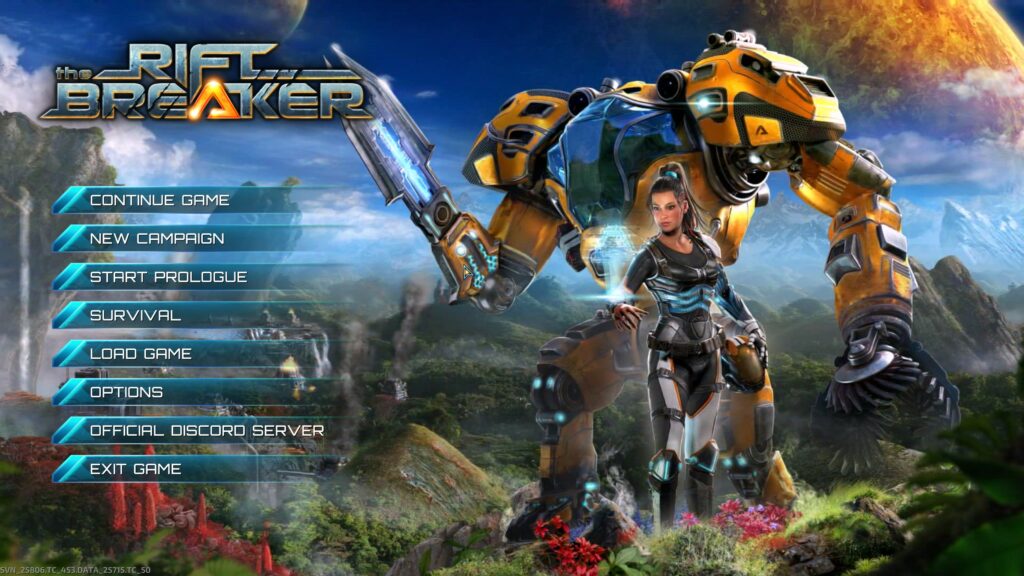
So, this is a game I remember seeing trailers for randomly and being very intrigued by, but then all coverage seemed to disappear into obscurity…until now. Riftbreaker is a game by Polish Developers EXOR Studios and is another spin on the tower defence genre. It is a mix of action RPG, Survival, and base building mixed with some tower defence. I hope you spread word of this review, because this game is fantastic, and I hope it sells well. There is also a demo on Steam that I highly recommend you check out.
Story
As Captain Ashley S. Nowak, “the Riftbreaker,” you enter a one-way Portal to Galatea 37, a distant planet at the far reaches of the Milky Way. Your purpose is to build and develop a base that will allow travel to and from Earth for further colonization. Ashley’s mecha-suit, which she calls “Mr. Riggs,” can withstand the harshest environmental conditions and has a full range of equipment for base construction, resource extraction, specimen gathering, and of course – combat. It is also capable of traveling through rifts that connect space across vast distances. What I can say about it, however, is the banter between Ashley and Mr. Riggs is thoroughly entertaining and there’s some brilliant bickering between each other which builds Ashley and Mr. Riggs’ character, who feels borderline human with some of his quips to Ashley. I was not expecting this to be a strong point of a game like this, but it is.
Music
There’s not too much to talk about here. The soundtrack is decent and goes with the game quite well; it’s serviceable at the least. The same can be said about the sound effects: the aliens sound solid, the weapons sound acceptable at least, the environmental sounds are great, and everything is very well mixed. Voice acting isn’t special, but the delivery is good, and the dialogue is great. Overall a very competent package.
Visuals
Visually, this is a very competent game. The mech Mr. Riggs is very well-designed. Nothing outstanding but it feels solid and far from amateur. His animations are also surprisingly decent and has a sense of weight while moving or attacking and foliage interacts as you walk through it. Even when using the dash ability the animations still maintain that sense of weight.
Enemies are well-designed and the animations are competent, but aren’t as visually striking as the mech and could have a bit more individual character to them as there are a variety of enemies. I would like to have seen a bit more here on feedback and a sense of weight and power from the larger enemies. However, I have to say that given the sheer number of enemies that can be on screen at the same time, I can understand why they may have intentionally opted for simpler animations.
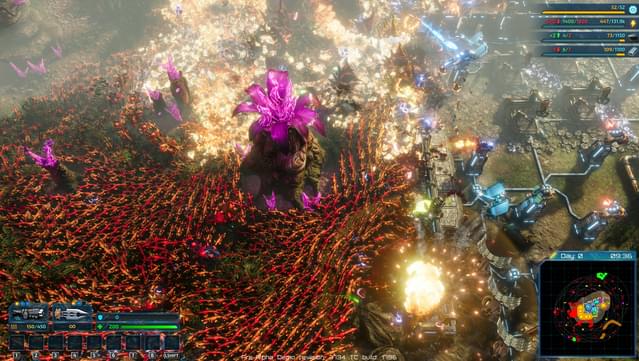
Further on the visual front, as mentioned the foliage interacts with you, which is nice to see, however, this is just the start. You can cut through everything with a sword which looks fantastic. Everything flies and drops in a visceral rage and the same can be said with other weapons such as the hammer. There is a nice shockwave that occurs, and everything goes flying. Environmental feedback here is fantastic and something a lot of games neglect. The weather effects overall are very solid too, although the hurricane is a bit weak.
Graphically, it’s very solid and above what I would consider average. Your suit has damage states, the lighting is very nice, and there’s RTAO. It has a nice colour palette, the shadows look solid when the “soft” option is chosen and there’s even an RT Shadows option which visually improves shadows with a 20% cost in performance. Whether the drop in performance is worth it is entirely subjective but the shadows do look objectively better with RT enabled.
Texture work is very adequate, with the effects being very solid and doesn’t overdo the alphas, which is a smart decision in terms of performance and artistically, in my opinion. Nothing to write home about but, like the sound, everything is competent and done well.
Gameplay
There is a Campaign mode with four difficulty settings and a hardcore option that disables respawning. Meaning, you have one life and one life only. There is also a Survival mode and sandbox mode. Regardless of which mode you choose, everything is procedurally generated with no multiplayer or co-op; this is a strictly solo affair.
Gameplay is where The Riftbreaker really shines, and very brightly at that. Like I said, this is a real mix of a game. You need to build a base, which requires you to gather resources that you can harvest manually, but is very sub-optimal to do. What you should do is focus on building structures that can harvest resources for you. This, however, has the usual caveat of requiring power, so you also need to ensure that you have the required energy for the structures you build. On that front, you will need to focus on building relatively smart early on. There are different kinds of energy generators and you start off with two: solar and wind. Wind is nowhere near as effective as solar, but works 24/7 where solar does not. You can also store extra energy.

Where things get interesting, however, is with the multiple weather events that happen in-game. From simple things such as rain and a lack of wind, which naturally affect your solar panels and wind generators, to severe events such as solar flares, hurricanes, acid rain, EMP storms, and so on, which can shut down your buildings and structures entirely. This is really great for two reasons: it puts emphasis on the building of good power solutions and backup batteries for when such events occur since you don’t want to have just solar panels or primarily solar panels on a planet that often has weather events that affect their energy production, and it also makes the world feel very organic and alive. This is fundamentally great game design.
Once you have your basic base built, you will then focus on the tasks you are given, which range from gathering more resources to progress your base, to scanning for certain materials, to looking for big enemies, exploring strange activity, and so on. There are also different biomes, which may require certain upgrades to Mr, Riggs to proceed. The tasks are nothing special, but they work in the world and often require a lot of preparation for big attacks and so on. As one would expect, you can eventually upgrade these structures. You can also build warp points across the planet to make travel significantly easier, just make sure it’s defended well.
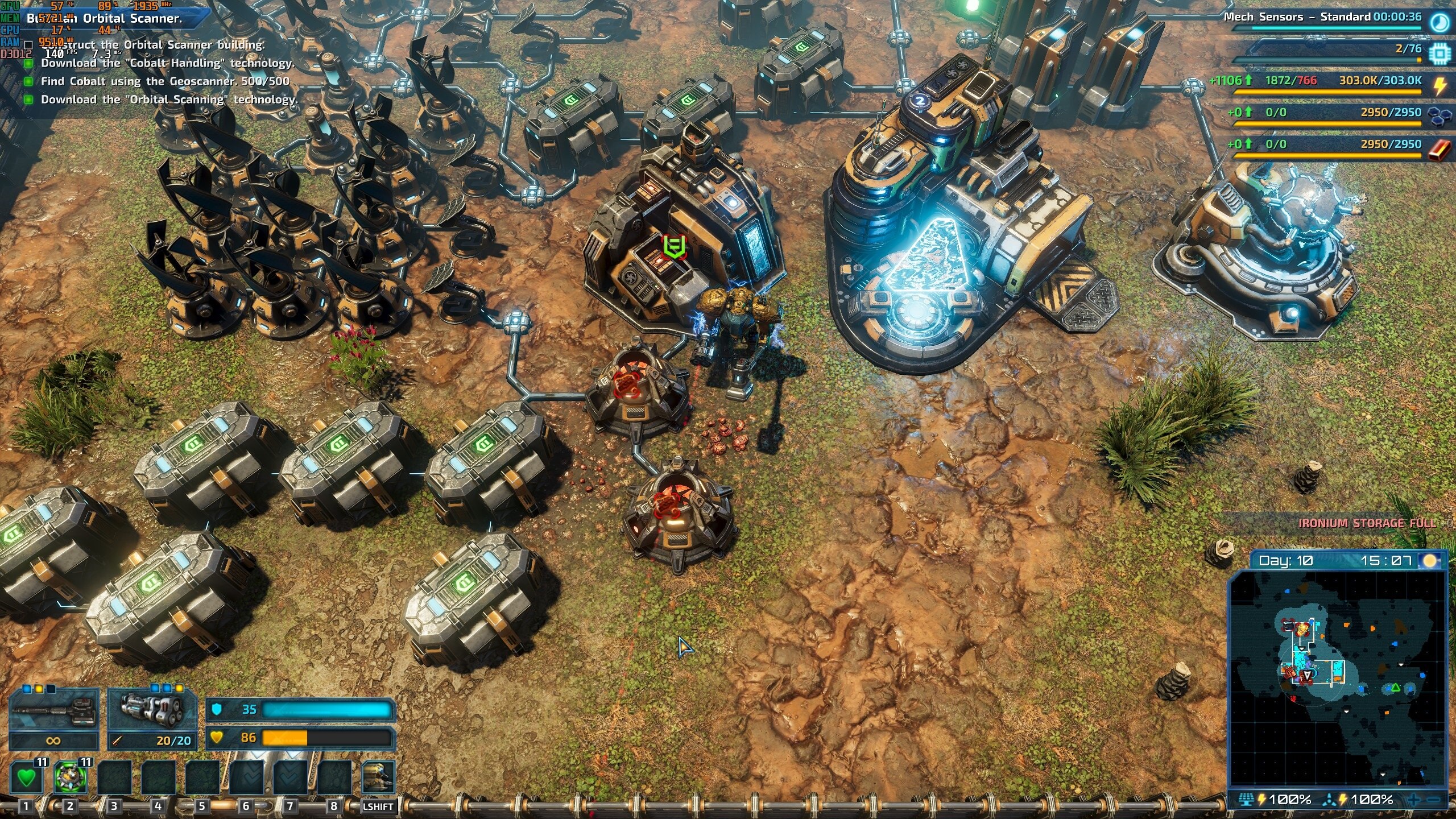
And this is where the Action RPG and tower defence elements come into play. Your base/bases will be attacked in waves and you’ll need to build solid defences and shore up your structures as well as taking part in the action yourself. Mr. Riggs has one movement slot and two arms that you can slot three weapons each, but you can only use one weapon per arm at a time with the ability to quick swap. You have things such as hammers, shotguns, rocket launchers, miniguns, railguns, and a lot more. There is an absolutely huge variety of weapons here and having multiple weapons on each arm, with four upgrade slots, really builds on that. Cosmetically, you can also change your mech’s skin. Building certain structures can also give you access to blueprints in your research tree.
Speaking of which, this is the one area where the game falters. The research tree is rather convoluted with the icons used being very odd and unclear. The game would’ve been better off if they had used actual images of the items instead of vague icons that just adds to the learning curve. I’ve placed a screenshot below so you can judge this for yourself. To be clear, I like the content in the skill tree, it’s just that the UI could be significantly improved.
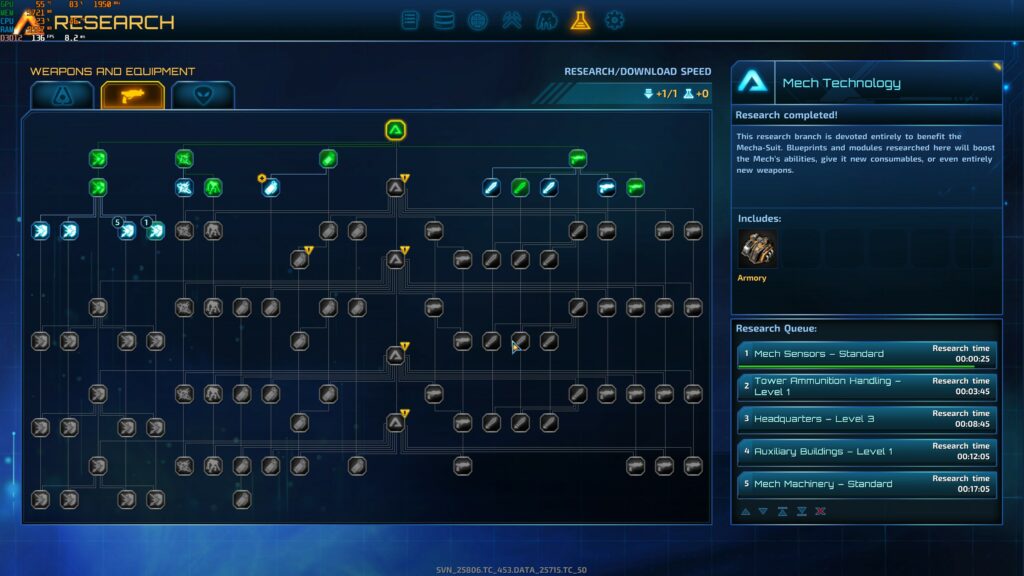
The survival mode is very much what you would expect: you start off with basic resources and must survive the enemy waves that come in. To balance this out, researching upgrades takes significantly less time than in the campaign mode. Sandbox mode allows you to go nuts with zero pressure and lets you experiment to find optimal solutions to the various problems you will face in the campaign.
The general loop in campaign mode is building up infrastructure, fighting off alien hordes, researching exotic wildlife, and so on, and is what fills up your task list. The order you do it is entirely up to you, however, even down to what biome you choose to visit next. You can also choose to just hunker down in a well-fortified base or conversely take the fight to the aliens yourself. There is no time limit or restrictions forcing you to play in a specific way or order. This makes for a very satisfying, zen-like loop that will absolutely melt the time away. I cannot praise this enough; there has clearly been a lot of thought here. The devs have also promised some serious long-term support, which should see this game only get more polished and improved over time.
Performance
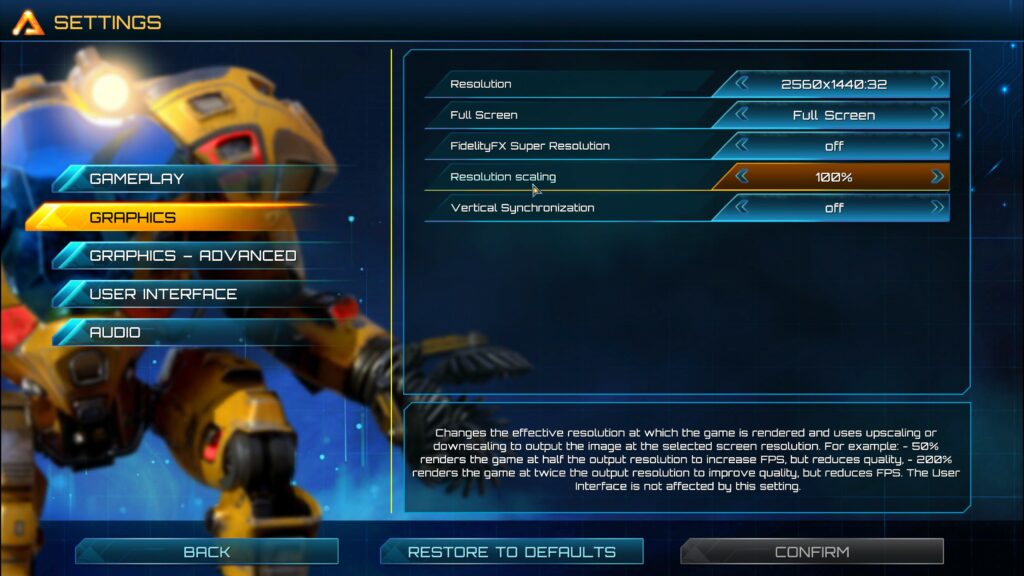
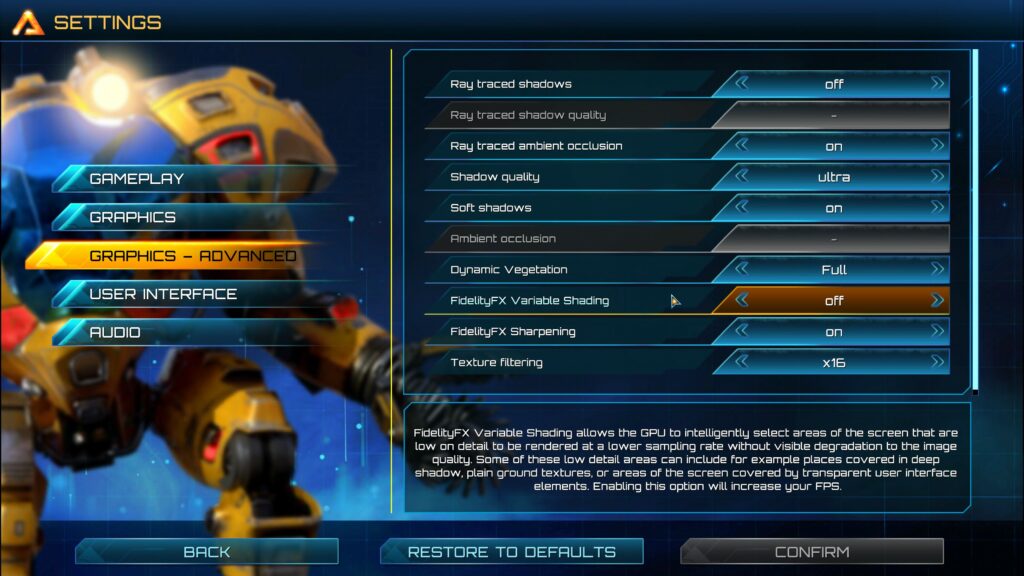
On my 8700K (4.7GHz on all cores), ASUS TUF RTX 3080 OC and 16GB LL DDR4 RAM @3600Mhz, I am happy to report it performs exceedingly well, so far. At 1440p with everything maxed, with RT shadows disabled, maxed out soft shadows and RTAO enabled, I get an average of 120-140 fps with it mainly being on the upper end of that. With RT Shadows enabled I may dip below 100, especially when the screen is littered with enemies. The fact that it is staying above 80 fps fully maxed with so much going on is thoroughly impressive. CPU usage in game and in the CPU benchmark suggests that there is room for more optimisation, however, as there is still computing power left on the table. RAM usage also peaks at just over 10GB total for the system, so I’d definitely recommend 12-16GB of RAM if you want to max this out. On the VRAM front, 6GB is more than sufficient. Overall, while the settings could be more granular, this is one of the most optimised games I have played in a while, which is more impressive coming from a small dev. They have done an exemplary job on optimisation. With the addition of FidelityFX Super resolution and Variable Shading, it should also scale very well with low-end rigs.
Conclusion
EXOR Studios have made a fantastic base-building, survival game with Action-RPG elements that has its own identity compared to similar games like Factorio, and offers hours upon hours of genuine fun with its zen-like gameplay loop. It stands tall in the genre with its unique weather elements and the well-written dialogue between Ashley and Mr. Riggs. It is a fantastic indie release and I can not recommend this game enough. If you like games like Factorion, you should absolutely get enjoyment out of this. At the time of this writing it has a 10% Launch discount on Steam and is priced at £22.49, which is an absolutely solid price point. The Rift breaker is available Xbox One, PlayStation 4, PlayStation 5, Xbox Series X and Series S, Microsoft Windows, and is also available on the Windows store, and EGS.